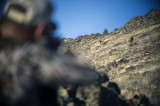If you could only pick one, what rifle caliber should you choose for big game hunting in North America?
This is a question we get over and over here at MeatEater, and the good news is that the average hunter can pretty much do it all with a single rifle. As fun as it might be, it’s really not necessary to get caught up in the minutiae of ballistics or the allure of wildcat or ultra-magnum calibers.
The vast majority of big game hunters on the North American continent use a range of calibers that fall between 6mm (.24 caliber) and .338 caliber cartridges. At the top end of the spectrum, the .338 Winchester Magnum packs the necessary punch to swiftly anchor a 1500 pound bull moose, but it’s certainly overkill for a ninety-pound antelope. At the low end, the .243 Winchester is enough medicine to cleanly kill small-bodied South Texas whitetails, but it lacks the power to reliably take down a big bull elk. (On a MeatEater shoot, we met a proud father who bragged that his son killed an elk with a .243; later, the son told the same story and mentioned a detail that his father failed to bring up — he shot it nine times before it died.)
With this caliber range in mind, hunters searching for one versatile big game cartridge should look towards the middle of the spectrum. Think about the animals you might be pursuing. Moose, black bears, and elk would be among the animals that require a caliber that can push a heavy enough bullet to penetrate thick hide and/or stout bones for a quick kill. Pronghorn antelope, Coues Deer, bighorn sheep and mountain goats live in country that might require accurate shots ranging out beyond 300 yards. Whitetail hunters in the Midwest might need to shoot quickly through thick brush at close range or reach clear across a cut cornfield. While there are many capable calibers to choose from, hunters who want a rifle cartridge that is both hard-hitting and far-reaching should consider the more popular thirty caliber rifle cartridges. They are the favorite choices of many one-rifle hunters.
When picking a single, do-it-all caliber, Steven Rinella considers the wide range of big game animals that he pursues. “I hunt all over North America for all sorts of big game. In the last handful of years, I’ve killed everything from muskoxen with a .375 H&H to wild pigs with a .270 to a mountain lion with a .243. The fact is, I could have done all of that, with total confidence, with a .300 Win Mag and everything would have turned out the same way: clean kills”. In short, he feels that the .300 Win Mag is capable of ethically killing just about every North American big game animal that he’s likely to encounter.
First Lite’s Ryan Callaghan agrees with Steve’s choice of the .300 Win Mag, citing its dependability in the field. “If you need to shoot long or short, big or small, if the house was burning down and you could only save one, I’d make it the 300 win mag”. This caliber is known for accuracy at distance and its heavier bullets resist being blown off course by a stiff wind. Callaghan says, “In western Montana, the .300 Win Mag is respected for long cross canyon shots during elk season. And I reach for it during antelope season as well because I expect longer shots in the constantly gusting eastern Montana winds.”
Another thirty caliber rifle cartridge that has proven itself on big game around the world is the .30-06. It’s remained relevant for over one hundred years for a reason: the .30-06 is probably responsible for killing more big game in North America than any other single cartridge. Janis Putelis, producer of the MeatEater television show, prefers the practicality of the .30-06.
“Any establishment that sells rifle ammunition, the world over, will most likely have .30-06 ammo, often in several bullet types and weights.” Some hunters question the long range capabilities of the 30-06, but Janis disagrees. “With a 200-yard zero, the maximum point blank range of a .30-06 is nearly 300 yards. Who needs to shoot farther than that? You shouldn’t, but if you do, simply mount a scope with a bullet drop compensating reticle on it, and you can shoot out past 500 yards.”
I’m also in the .30-06 camp. Like many other Pennsylvania deer hunters, the .30-06 was something I graduated to after hunting with hand-me-down .30-30s and inaccurate slug-guns. For me, the .30-06 has performed flawlessly since I killed my first whitetail buck in Pennsylvania over thirty years ago. I see no reason to change now. In the last dozen years, I’ve killed over thirty big game animals on rifle hunts at ranges from twenty to over three hundred yards with the .30-06. All died quickly from a single shot with the exception of two bull elk that received quick and likely unnecessary follow-up shots. I trust my .30-06 for everything from hunting antelope and mule deer in open country to stalking elk and black bears in thick timber.
Hunters these days can choose from a lot of proven big game cartridges. Personal opinion and first-hand experience play big roles in arguments about the best rifle caliber. But the .30-06 and the .300 Win Mag can do it all. However, no matter what big game caliber you shoot, all hunters must put accuracy above all other considerations. No amount of bullet weight or speed will overcome poor shot placement. Practice at the range until you have total confidence in your rifle’s accuracy. Limit your shots on big game animals to distances that you can consistently hit the bullseye time and again. Follow these rules and you will find that you can successfully hunt a lifetime’s worth of big game, all with with a single caliber.





